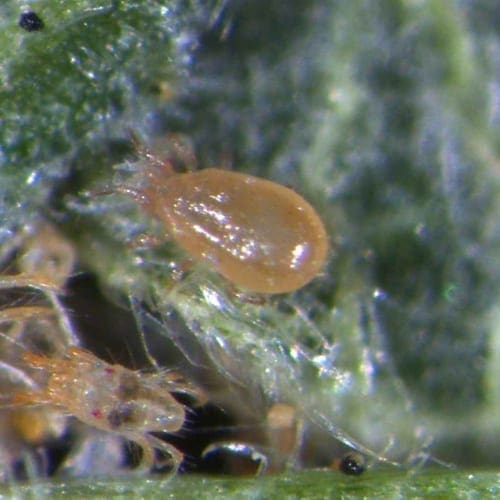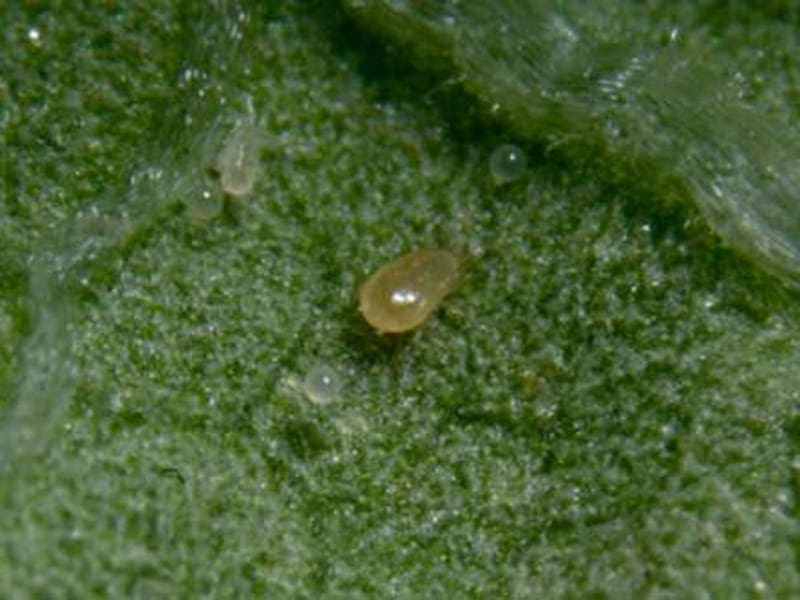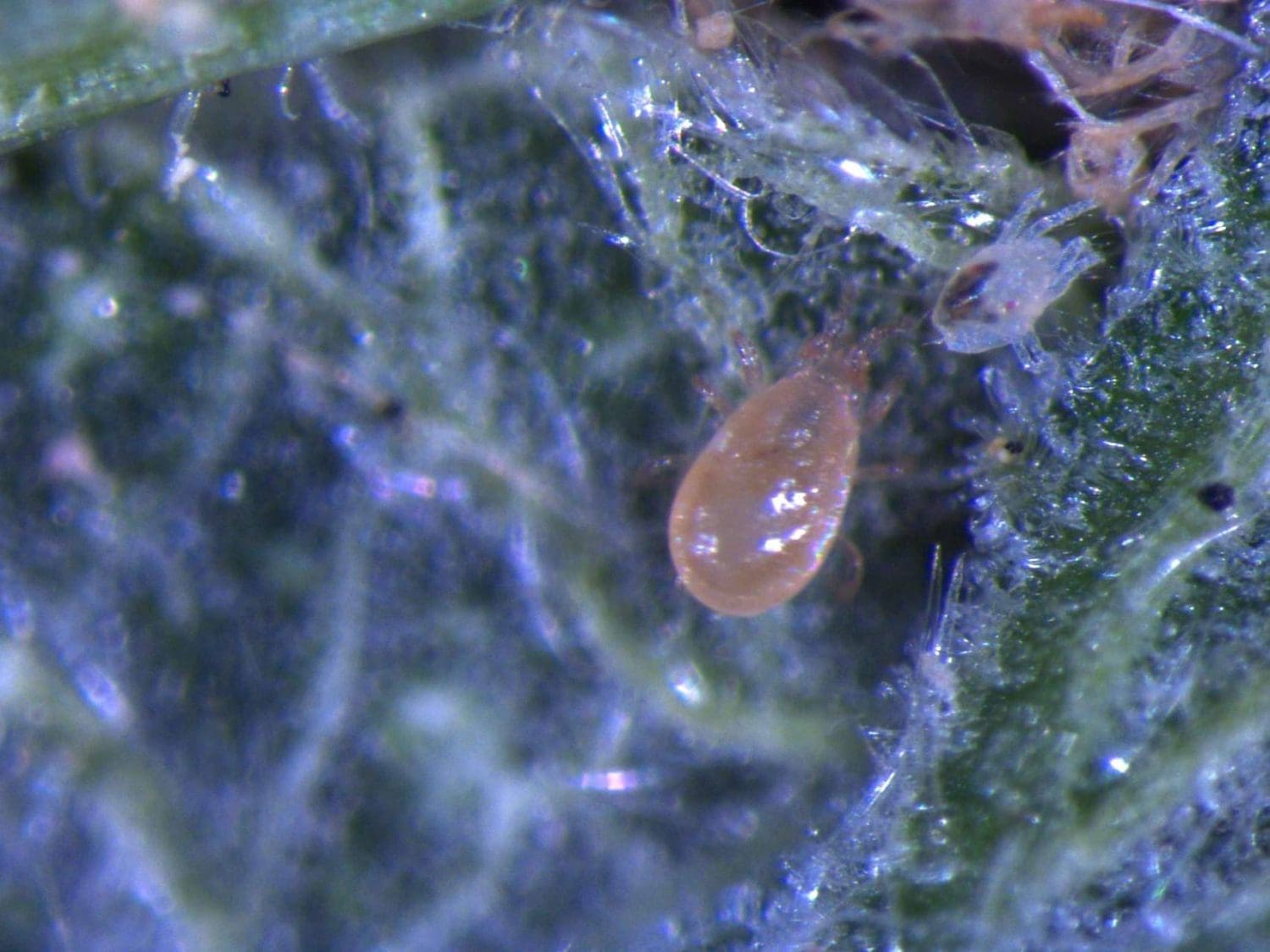Description
Californicus (Neoseiulus californicus) are aggressive and robust predatory mites. They feed on a range of pest mites, other small invertebrates and pollen. Adults can consume 5 adult spider mites per day. They survive well at low prey densities due to their ability to use alternate prey and pollen as a food source.
Californicus tolerate a wide range of environmental conditions and can be used in situations where other predatory mites may struggle. They are active at both high and low temperatures and they withstand low humidity better than many other predatory mites. At 30°C they complete their lifecycle in 4 days (twice as fast as two-spotted spider mite).
Californicus are generally less sensitive to pesticide residues than other predatory mites. They can establish earlier than Persimilis in some situations where toxic pesticides have been used.
Californicus are <1 mm long, pear-shaped and their colour varies depending on diet. The eggs are clear to white, oval shaped, and larger than spider mite eggs (which are round). Californicus tend to lay their eggs on the underside of leaves, in sheltered areas along veins or on leaf hairs.
Download our Californicus technical information sheet here.
Key target pests
- Two-spotted spider mite
- Broad mite
- Cyclamen mite
Advantages
- Applicable in many crops
- Eat all spider mite stages
- Survive at low prey densities
- Can be introduced preventatively
- Effective under hot, dry conditions
- Can survive short periods above 40°C
- Often establish earlier than Persimilis in situations where toxic pesticides have been used
- Suitable for drone release
Suitable crop environments
Californicus can be use in a wide range of field and protected crops including fruits, vegetables and ornamentals. They are also suitable for indoor plantscapes. They perform best at 40-80% relative humidity and at temperatures of 16-32°C. Californicus outperform Persimilis under hot, dry conditions and in crops where temperature and or humidity change dramatically.
Release rates
Unlike chemicals, when it comes to beneficials, more is always better. However, they are costly to produce and our goal is to achieve the best results at minimal expense. There are many factors to consider, including the value of the crop, the severity of the pest outbreak and the activity (or otherwise) of naturally occurring beneficial species.
As a general rule, 2-3 releases of modest numbers is better than a single large release. This reduces risk, improves establishment and accelerates the development of multiple overlapping generations. In most cases our releases are inoculative and we anticipate that our beneficials will establish and breed up within the crop to give long term control. An ongoing regular release program may be warranted in dynamic environments where plants are moved regularly or other influences (e.g. fungicides) adversely impact predators.
Release rates will vary depending on the crop and level of infestation. The table below is only a guide – contact us for specific recommendations.
| Situation | Release rate (per release) | No. of releases | Interval between releases |
| Preventative | 10-25 mites/m2 | 3 | 2-3 weeks |
| Curative | 50-100 mites/m2 | as required | 1-2 weeks |
| Hotspot treatment | 100-200 mites/m2 | as required | 1-2 weeks |
When to release
Californicus should be introduced preventatively or at the first sign of pest activity. Inspect crops regularly for the presence of pest mites, especially on the windward side, in dry spots and at edges. If pest numbers are already high, consider applying a compatible miticide prior to release. Californicus can be used with Persimilis predatory mites to manage difficult situations.
How to release
Before release, check prior history of chemical applications to ensure toxic residues are no longer present. See notes on chemical use below.
Californicus are mixed with vermiculite and packed in cardboard tubes. They should be released as soon as possible after delivery. If necessary, tubes can be stored (on their side) for up to 3 days at 10-18°C. After cool storage mites will initially be slow moving and hard to detect.
Roll the tubes gently before release to distribute mites evenly. Remove the end cap, take away the breathable cloth and replace the cap to use as a shaker. Distribute the contents of each tube over the foliage. During release keep an eye out for pest hotspots and be prepared to place additional mites in these areas.
After release
Californicus will be difficult to find for a week or so after introduction. They disperse quickly in search of food. Mark a few places where predatory mites were released, especially those with good numbers of pest mites. These sites can be checked regularly to assess pest numbers and establishment of predatory mites. Look for Californicus eggs, as this is a good early sign of predator establishment. Initially pest mite numbers may continue to increase, while Californicus establishes.
If pest mites increase to damaging levels, a compatible miticide can be applied to reduce their numbers. This will allow the predators to catch up. Spot spraying is preferable to blanket spraying.
Cultural practices to aid establishment
- Minimise dust and ensure plants are well watered and in good health to provide optimal conditions at the plant surface where the mites are active
- A relative humidity of at least 60% will improve establishment
- In protected cropping environments, consider additional wetting of floors and benches
- Increase availability of pollen (e.g. through mowing alternate rows in orchards and vineyards)
- Adding Nutrimite pollen directly to the foliage of indoor crops can be a valuable tool for enhancing populations of Californicus mites when pest levels are low or anytime a boost in numbers is required.
- Avoid application of pesticides for at least three days after release if possible
Chemical use
While some pesticides are not harmful to predatory mites, many are directly toxic or have sublethal effects. These can prevent predators from establishing and/or reduce their efficacy.
If pesticides are required, always check for side-effects and select products that are least harmful to Californicus and other key beneficials in your IPM program. Use the Biobest Side Effects app or access the Biobest side-effects manual online.
Some insecticides (e.g. synthetic pyrethroids, organophosphates and neonicotinoids) can have residual toxicity that affects Californicus for many weeks. Fungicides generally have low toxicity to Californicus, however some (e.g. mancozeb and chlorothalonil) are highly disruptive. The safest miticides to use with Californicus are bifenazate (Acramite), clofentezine (Apollo), fenbutatin oxide (Torque) and hexythiazox (Calibre).
Californicus in action
The video clip below shows californicus feeding on a spider mite egg.
Further information







Minh Tri (verified owner) –
These guys are awesome… they helped clean up the spider mites well. It takes about 2 weeks for the mites to significantly increase their population and they are very fast running around the plants in my garden.
andywilliamsau (verified owner) –
I have had so many seasons of my crops ruined by mites and have tried every spray in an attempt to control them to no avail. After just three weeks of releasing these mites there is no sign of the broad mites i had on my winged beans and capsicum (Or the ones that normally attack my english spinach). All of the crops that were damaged are regrowing new growth that has not been attacked for the first time. It will be interesting to see how long they hang around in the garden and if they control russet mites but so far so good.